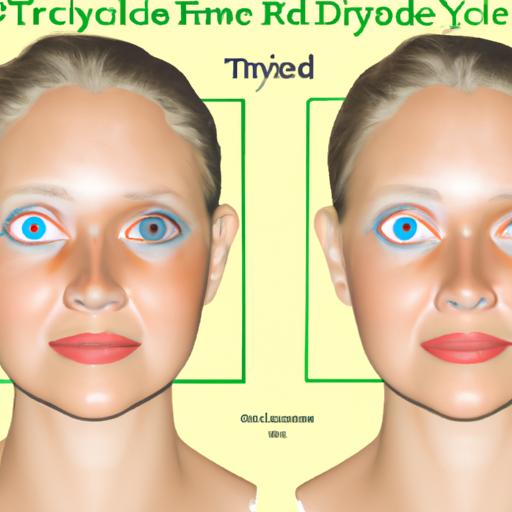Underactive thyroid eye disease symptoms: How to identify and manage them
Introduction

An underactive thyroid is a common condition that affects millions of people worldwide. It occurs when the thyroid gland does not produce enough hormones to regulate the body’s metabolic rate. One of the lesser-known symptoms of an underactive thyroid is thyroid eye disease. This disease causes the muscles and tissues around the eyes to become inflamed, leading to a range of symptoms that can affect vision and overall quality of life.
In this article, we will explore the symptoms of underactive thyroid eye disease and how to identify and manage them effectively. We will also discuss the causes, risk factors, diagnosis, and treatment options available for this condition.
What is an underactive thyroid?
An underactive thyroid, also known as hypothyroidism, occurs when the thyroid gland does not produce enough hormones to regulate the body’s metabolic rate. This can lead to a variety of symptoms, including fatigue, weight gain, cold intolerance, and dry skin.
There are several causes of an underactive thyroid, including autoimmune disorders, radiation therapy, and certain medications. Women over the age of 60 are also at a higher risk of developing an underactive thyroid.
Managing an underactive thyroid involves taking thyroid hormone replacement therapy, which replaces the hormones that the thyroid gland is not producing. This helps to regulate the body’s metabolic rate and reduce the symptoms of hypothyroidism.
If left untreated, an underactive thyroid can lead to more severe complications, including heart disease, nerve damage, and infertility. Therefore, it is essential to seek medical attention if you suspect you may have an underactive thyroid.
What is thyroid eye disease?
Thyroid eye disease, also known as Graves’ ophthalmopathy, is an autoimmune condition that affects the tissues and muscles around the eyes. It is most commonly associated with hyperthyroidism, which is an overactive thyroid. However, it can also occur in people with hypothyroidism or normal thyroid function.
The exact cause of thyroid eye disease is not fully understood. However, it is believed to be an autoimmune disorder, which means the immune system mistakenly attacks the tissues and muscles around the eyes. Other risk factors for thyroid eye disease include smoking, family history, and age.
The effects of thyroid eye disease on the eyes and vision can vary from person to person. Some people may experience mild symptoms, while others may have severe symptoms that affect their daily life. Common symptoms include bulging eyes, dry eyes, double vision, redness, and swelling around the eyes.
Symptoms of underactive thyroid eye disease
When someone with an underactive thyroid develops thyroid eye disease, it can be challenging to distinguish the symptoms from those of the thyroid disorder alone. However, there are some common symptoms of underactive thyroid eye disease that individuals should be aware of.
The most common symptoms of underactive thyroid eye disease include eye discomfort, redness, and swelling around the eyes, double vision, and light sensitivity. Patients may also experience a gritty feeling in their eyes, tearing, and difficulty moving their eyes in different directions.
It is essential to identify and manage the symptoms of underactive thyroid eye disease as soon as possible. The longer the disease goes untreated, the more severe the symptoms may become, leading to permanent vision loss in some cases. If you experience any of these symptoms, it is essential to seek medical attention immediately.
The impact of underactive thyroid eye disease symptoms on daily life can be significant. It can affect an individual’s ability to drive, read, or perform other everyday activities. Therefore, it is crucial to manage the symptoms of underactive thyroid eye disease through proper medical treatment and lifestyle changes.
Diagnosis and treatment of underactive thyroid eye disease
Diagnosis of underactive thyroid eye disease
Diagnosing underactive thyroid eye disease involves a thorough examination of the eyes and the surrounding tissues. Your doctor may use imaging tests such as CT scans or MRI to get a better view of the affected area. Blood tests may also be ordered to check for thyroid hormone levels and antibodies that may be causing the inflammation.
Treatment options for underactive thyroid eye disease
There are several treatment options available for underactive thyroid eye disease, depending on the severity of the symptoms. Mild cases may be treated with artificial tears or lubricating eye drops to relieve dryness and discomfort.
In more severe cases, your doctor may prescribe corticosteroids to reduce inflammation and swelling around the eyes. Immunosuppressive drugs may also be used to prevent the immune system from attacking the tissues around the eyes.
In some cases, surgery may be necessary to correct vision problems caused by underactive thyroid eye disease. Surgical options may include decompression surgery, which involves removing or repositioning the tissues around the eyes to relieve pressure and improve vision.
Management of underactive thyroid eye disease symptoms
Managing underactive thyroid eye disease symptoms involves regular monitoring and treatment to prevent complications and reduce discomfort. It is essential to follow your doctor’s instructions for taking medication and attending regular check-ups to ensure that the condition is being managed effectively.
Other lifestyle changes such as quitting smoking and reducing alcohol consumption may also help to reduce the severity of underactive thyroid eye disease symptoms.
Conclusion
In conclusion, underactive thyroid eye disease is a lesser-known symptom of an underactive thyroid that can have a significant impact on vision and overall quality of life. It is essential to seek medical attention if you experience any of the symptoms mentioned in this article, as early diagnosis and treatment can prevent complications and improve outcomes.
If you have been diagnosed with underactive thyroid eye disease, there are several treatment options available to manage your symptoms effectively. Follow your doctor’s advice and attend regular check-ups to ensure that your condition is being managed properly.
At Zahnweiss Info, we are dedicated to providing the latest updates on dental health news and treatments. If you have any questions or concerns about underactive thyroid eye disease or any other dental or medical conditions, please do not hesitate to contact us.




